Description
PHARMACOKINETICS AND PHARMACODYNAMICS:
Zolpidem is a hypnotic belonging to the imidazopyridine family. Experimental studies have shown a sedative effect at doses below that necessary to obtain anticonvulsant, muscle relaxant or anxiolytic effects. These effects can be explained by a selective agonist action of the GABA-omega macromolecular receptor complex, modulating the opening of the chloride channel. Zolpidem binds preferentially under the omega 1 subtype. In humans, zolpidem shortens sleep time, reduces the number of nocturnal awakenings, increases sleep duration, and improves sleep quality.
These effects are associated with a characteristic electroencephalographic profile, which differs from that of benzodiazepines. Nocturnal sleep monitoring studies have shown that zolpidem prolongs phase II, as well as phases III and IV (deep sleep). At the recommended dose, zolpidem does not influence the total duration of paradoxical sleep (REM or Rapid Eye Movement). If this product does not meet your needs or interests, you may want to look at Nocte Ambien Zolpidem. Please visit this link for further information on our Sleeping Disorders Pills
Absorption: After oral administration, zolpidem has a bioavailability of approximately 70% with a maximum plasma concentration between 0.5 and 3 hours.
Both absorption and onset of the hypnotic effect of zolpidem are rapid. After oral administration, the bioavailability is 70%. At therapeutic doses, it shows linear kinetics. The therapeutic plasma level is between 80 and 200 ng/ml. With zolpidem sublingual tablet, peak plasma concentrations are reached between 0.25 and 3.5 hours after administration. Median time to Cmax was similar compared to a conventional tablet. However, early plasma concentrations at 5-15 minutes were higher with zolpidem Sublingual Tablet.
Distribution: At therapeutic doses, its pharmacokinetics are linear. Plasma protein binding is approximately 92%. The volume of distribution in adults is 0.54 ± 0.02 L/Kg and decreases to 0.34 L/kg in the elderly.
First-pass metabolism in the liver corresponds to approximately 35%. Repeated administration has been shown not to change protein binding, indicating the absence of competition between zolpidem and its metabolites for binding sites.
Elimination: Zolpidem is eliminated in the form of inactive metabolites (hepatic metabolism), mainly in the urine (about 60%) and in the feces (about 40%). It has no inducing effect on liver enzymes.
The elimination half-life is short. The mean elimination half-life of zolpidem after dosing was 2.85 hours (5 mg) and 2.65 hours (10 mg). The duration of action of zolpidem is up to 6 hours.
The plasmatic elimination half-life is on average 2.4 hours (0.7-3.5 hours).
All metabolites are pharmacologically inactive and are excreted in urine (56%) and feces (37%).
In trials, zolpidem has been shown to be non-dialyzable.
Special populations:
In the elderly subject, a decrease in hepatic clearance is observed. The concentration peak is increased by approximately 50% without significant prolongation of the half-life (3 hours on average). The volume of distribution decreases to 0.34 ± 0.05 L/kg.
In patients with renal insufficiency, whether on dialysis or not, a moderate decrease in renal clearance is observed. No dose adjustment is necessary in patients with compromised renal function.
The other kinetic parameters are not modified. Zolpidem is not dialyzable.
In patients with severe hepatic impairment, the bioavailability of zolpidem is increased. Its clearance is significantly reduced and the elimination half-life is prolonged (approximately 10 hours).
In the comparative bioavailability study between sublingual tablets, containing 5 mg of Zolpidem tartrate manufactured by Armstrong Laboratorios de México, SA de CV (pharmaceutical alternative), and Stilnox ® tablets, containing 10 mg of zolpidem tartrate (reference drug ) , Prepared by Sanofi-Aventis de México, SA, the following results regarding its pharmacokinetics are reported:
|
Comparative Bioavailability Study NOCTE ® Sublingual vs. Stilnox ® (fasting) n = 16 |
Tmax (h) |
T ½ (h) |
Cmax (ng/mL) |
ABC0- ∞ (h*ng/mL) |
|
NIGHT ® 10 mg (2 tablets of 5 mg) Sublingual tablet |
1.190 (±0.835) |
3.206 (±0.727) |
197,937 (±76,795) |
798,592 (±317,609) |
|
Stilnox ® 10 mg oral tablets |
0.825 (±0.618) |
3,086 (±0.706) |
212,574 (±66,553) |
789,415 (±302,516) |
With the results obtained in the study, it is concluded that both products present a comparative Bioavailability.
Pharmacodynamics:
Pharmacotherapeutic group: Hypnotics and Sedatives, Drugs related to benzodiazepines.
ATC code: N05CF02.
Zolpidem, an imidazopyridine, is a hypnotic agent analogous to benzodiazepines. In experimental studies, it has been shown to have sedative effects at doses lower than those necessary to exert anticonvulsant, muscle relaxant, or anxiolytic effects. These effects are related to a specific agonist action at central receptors belonging to the “GABAA-ω macromolecular receptor complex (BZ1 and BZ2)”, which modulates the opening of the chloride ion channel. Zolpidem acts primarily on the ω1 (BZ1) receptor subtypes.
Zolpidem has been shown to be effective in the short-term treatment of insomnia, which is characterized by difficulty initiating sleep.
In general, zolpidem sublingual tablets at a dose of 5 mg reduce the latency period to persistent sleep by approximately ten minutes relative to conventional tablets containing 10 mg.
Zolpidem also stimulates the maintenance of sleep. No differences in sleep maintenance efficacy parameters (wakefulness after sleep onset and total sleep duration) have been observed between sublingual tablets and conventional oral tablets.
Zolpidem is indicated for the short-term treatment of transient insomnia. A study showed usefulness in the treatment of chronic insomnia, NOCTE ® allows a rapid reconciliation of sleep, reduces the number of nocturnal awakenings, increases the duration of sleep and improves its quality.
CONTRAINDICATIONS:
This drug is contraindicated in the following cases:
• Acute and/or severe respiratory failure.
• Severe liver failure.
• In patients with severe liver failure, benzodiazepines and related substances can precipitate encephalopathy, which is why their use is contraindicated.
• Hypersensitivity to zolpidem, to the components of the formulation or to some of its inactive metabolites. Observed reactions include anaphylaxis and angioedema (see General Precautions).
• Pregnancy and lactation.
• Under 18 years of age.
• Sleep apnea syndrome.
• Myasthenia gravis.
This medication is not recommended in the following cases: association with alcohol and anxiety linked to depression.
Hypnotics are not recommended as primary treatment in psychotic illness.
RESTRICTIONS OF USE DURING PREGNANCY AND BREASTFEEDING:
Zolpidem should not be administered during pregnancy.
Animal studies do not indicate direct or indirect harmful effects with respect to reproductive toxicity.
Zolpidem crosses the placental barrier.
A large amount of data collected from cohort studies have shown no evidence of the development of malformations after exposure to benzodiazepines during the first trimester of pregnancy. However, in certain epidemiological case-control studies, an increased incidence of cleft lip and palate was observed with benzodiazepines.
Cases of reduced fetal movement and fetal heart rate variability have been described after the administration of benzodiazepines during the second and/or third trimester of pregnancy.
Zolpidem administration during the last trimester of pregnancy or during labor has been associated with effects of hypotonia, hypothermia, feeding difficulties (which may result in poor weight gain), and respiratory failure, due to the pharmacology of the drug. . Severe cases of neonatal respiratory failure have been reported. An increased incidence of cleft lip and palate has been observed with benzodiazepines.
In addition, children born to mothers who take sedative/hypnotic agents chronically during late pregnancy may develop physical dependence and may present with withdrawal symptoms in the postnatal period. Appropriate monitoring of the newborn in the postnatal period is recommended.
Yes NIGHT ®is prescribed to a woman of childbearing potential, she should be advised to contact her doctor to withdraw treatment with zolpidem if she intends to become pregnant or suspects that she is pregnant.
Lactation: Although the passage of Zolpidem in breast milk is low, the product should not be administered during lactation.
SIDE AND ADVERSE REACTIONS:
Adverse events were classified using the MedDRA dictionary and classified according to the “Council for International Organizations of Medical Sciences” (CIOMS), with the following definitions:
Very common ≥10%; frequent ≥1 and <10%; Uncommon ≥ 0.1 and <1%; Rare ≥ 0.01 and < 0.1% and Very Rare < 0.01%. Not Known: Cannot be estimated based on available data.
There is evidence of Zolpidem treatment-related adverse reactions, particularly for certain central nervous system (CNS) events. These decrease, in theory, if zolpidem is taken immediately before going to bed or in bed. They are more common in elderly patients.
In patients with respiratory failure, it is convenient to take into account the possible depressant effect of benzodiazepines and related substances.
Zolpidem administration aggravates the symptoms of myasthenia gravis . Its use is recommended only in exceptional cases and under strict medical supervision.
If the duration of sleep is insufficient, the risk of altered wakefulness is increased.
Sedation, amnesia, concentration difficulties and muscular disorders can impair the ability to drive vehicles or operate machines. Vehicle drivers and machine operators should be informed about the possible risk of drowsiness the morning after zolpidem administration. To minimize this risk, it is recommended to sleep without interruption for 7-8 hours. overnight.
Adverse events appear in relation to individual sensitivity and often within an hour of taking the medication if the person does not lie down and fall asleep immediately.
Nervous System Disorders:
Common: Drowsiness, headache, fainting, exacerbated insomnia, cognitive disorders such as: anterograde amnesia (the amnesic effect may be associated with inappropriate behavior).
Uncommon: Paresthesia, tremor, attention disturbance, speech disorder.
Rare: Decreased alertness.
Psychiatric Disorders:
Common: Hallucinations, agitation, nightmares, depression (See General Precautions section).
Uncommon: Confusion and irritability, agitation, aggression, sleepwalking (See General Precautions section), euphoric state.
Rare: Altered libido.
Very rare: delusion, dependence (withdrawal symptoms or rebound effects may occur after discontinuing treatment).
Not known: abnormal behavior.
Most of the undesirable psychiatric effects are related to paradoxical reactions, euphoric mood.
General Disorders and Administration Site Conditions:
Common: Fatigue.
Rare: Gait disturbances, falls (predominantly in elderly patients and when zolpidem was not administered according to the prescribing information) (See General Precautions section).
Not Known: Drug tolerance.
Eye disorders:
Uncommon: Diplopia, blurred vision.
Very rare: Visual impairment.
Respiratory, Thoracic and Mediastinal Disorders:
Uncommon: Cough, dry throat and throat irritation.
Very rare: Respiratory depression (see section General precautions).
Gastrointestinal disorders:
Common: Diarrhoea, nausea, vomiting and abdominal pain.
Musculoskeletal and Connective Tissue Disorders:
Common: Low back pain.
Uncommon: Arthralgia, myalgia, muscle spasms, neck pain, muscle weakness.
Infections and Infestations:
Common: Upper respiratory tract infection and Lower respiratory tract infection.
Metabolic and nutrition disorders:
Uncommon: Appetite disorder.
Skin and subcutaneous tissue disorders:
Uncommon: Rash, pruritus, and hyperhidrosis.
Rare: Urticaria.
Alterations of the immune system:
Unknown: Angioneurotic edema.
Hepatobiliary disorders:
Uncommon: Elevation of liver enzymes.
Rare: Hepatocellular, cholestatic or mixed damage (See section on Dosage and route of administration, Contraindications and General precautions).
It has been observed that, in case of regular use of benzodiazepines or related substances with a short duration of action, certain withdrawal symptoms may appear between two consecutive doses, particularly when the dose is strong; however, this has not occurred with zolpidem at the recommended dose and duration of treatment.
Rebound insomnia: The sudden interruption of a prolonged hypnotic treatment or with doses higher than those recommended can cause a rebound of transient insomnia (exaggerated recurrence of the insomnia that motivated the treatment) and can also be accompanied by other symptoms (mood changes, anxiety and agitation ).
It is therefore appropriate to reduce the dose gradually and inform the patient of this.
These symptoms can appear especially in elderly people.
PRECAUTIONS IN RELATION TO EFFECTS OF CARCINOGENESIS, MUTAGENESIS, TERATOGENESIS AND ON FERTILITY:
Carcinogenicity: Zolpidem was administered to mice and rats for 2 years at oral doses of 4, 18, and 80 mg base/kg. In mice, these doses are approximately 2.5, 10, and 50 times the maximum recommended human dose (MDHR) of 10 mg/day (8 mg zolpidem base) on a mg/m 2 basis . In rats, these doses are approximately 5, 20, and 100 times the MDHR on a mg/m 2 basis . In mice, no evidence of carcinogenic potential was observed. In mice, renal tumors (lipoma, liposarcoma) were observed at the medium and high doses.
Mutagenesis: Zolpidem was negative in genetic toxicology assays in vitro (bacterial reverse mutation, mouse lymphoma, and chromosome aberration) and in vivo (mouse micronucleus).
Impairment of Fertility: Oral administration of zolpidem (doses of 4, 20, and 100 mg base/kg) to rats prior to and during mating and continued in females until postpartum day 25 resulted in irregular heat cycles. and prolonged pre-coital intervals with the highest dose tested. The no-effect dose for these findings is approximately 24 times the MDHR on a mg/m 2 basis . There was no impairment of fertility with any of the doses tested.
DRUG INTERACTIONS AND OTHER GENDER:
Caution is necessary when using other psychoactive medications.
Co-administration of muscle relaxants may potentiate the muscle relaxant effect and the risk of falls, especially in elderly patients and at higher doses (see General Precautions).
Zolpidem must not be administered in combination with alcohol. When the medicine is used in combination with alcohol, an increase in the sedative effect may occur, which affects the ability to drive or use machines.
Alcohol: The concomitant intake of alcohol is not recommended. The sedative effect is increased when zolpidem is used in combination with alcohol. This affects the ability to drive and use machines.
Increased depressive effect on the central nervous system may occur in cases of concomitant use of zolpidem with antipsychotics (neuroleptics), hypnotics, anxiolytics/sedatives, antidepressants, analgesics, narcotics, antiepileptic drugs, anesthetics, sedative antihistamines. However, in the case of selective serotonin reuptake inhibitor antidepressant agents such as fluoxetine and sertraline, no pharmacodynamic or pharmacokinetic interactions were observed. In the case of narcotic analgesics, the increase in the sensation of well-being can contribute to an increase in psychological dependence.
CNS depressants: Increased depressant effect on the central nervous system may occur when zolpidem is used concomitantly with antipsychotics (neuroleptics), hypnotics, anxiolytics/sedatives, antidepressants, narcotic analgesics, antiepileptic drugs, anesthetics, and sedative antihistamines. Concomitant use of zolpidem with these drugs may increase dizziness and psychomotor impairment, including impaired driving skills.
In addition, isolated cases of visual hallucinations have been reported in patients treated with zolpidem in combination with antidepressants, including bupropion, desipramine, fluoxetine, sertraline, and venlafaxine (see PRECAUTIONS).
Concomitant administration of fluvoxamine may increase zolpidem plasma concentrations, therefore its combined use is not recommended.
Therefore, caution should be exercised when zolpidem is used in combination with other CNS depressants.
In the case of narcotic analgesics, increased euphoria may contribute to increased psychological dependence.
Opioids: Concomitant use of benzodiazepines and other sedative-hypnotic drugs, including zolpidem, and opioids increases the risk of sedation, respiratory depression, coma, and death, due to the additive CNS depressant effect. Limit the dose and duration of concomitant treatment of benzodiazepines and opioids (See General Precautions section).
Cytochrome P450 inhibitors: Compounds that inhibit cytochrome P450 may increase the activity of some hypnotics such as zolpidem. Zolpidem is metabolized via the liver by several cytochrome P450 enzymes, the main enzyme being CYP3A4 with a contribution from the enzyme CYP1A2. The pharmacodynamic effect of zolpidem is decreased when co-administered with a CYP3A4 inducer such as rifampicin and St. John’s wort. St. John’s wort has been shown to decrease mean Cmax and AUC (33.7% 30.0%, respectively) when zolpidem alone was compared to St. John’s wort. Therefore, its concomitant use is not recommended as it decreases zolpidem blood levels.
Rifampicin induces the metabolism of zolpidem, resulting in an approximately 60% reduction in peak plasma concentrations and possibly decreased efficacy. Similar effects can be expected with other potent inducers of cytochrome P450 enzymes, such as carbamazepine, phenytoin, and St. John’s wort; Concomitant use is not recommended.
Compounds that inhibit hepatic enzymes (particularly CYP3A4) may increase plasma concentrations and potentiate the activity of zolpidem. Concomitant administration of ciprofloxacin may increase zolpidem plasma concentrations, therefore its combined use is not recommended.
However, when zolpidem was administered with itraconazole (CYP3A4 inhibitor), the pharmacokinetics and pharmacodynamics were not significantly changed. The clinical relevance of these results is unknown.
Co-administration of zolpidem with ketoconazole (200 mg twice daily), a strong CYP3A4 inhibitor, prolonged the elimination half-life of zolpidem and resulted in an increase in total AUC; in addition, a clear decrease in clearance of zolpidem was observed when compared to placebo. Total AUC for zolpidem, when administered with ketoconazole, was moderately increased by a factor of 1.83 compared to zolpidem alone. No zolpidem dose adjustment is necessary; however, the patient should be informed of the increased hypnotic effect with concomitant administration of zolpidem and ketoconazole.
Fluvoxamine is a strong inhibitor of CYP1A2 and a moderate to weak inhibitor of CYP2C9 and CYP3A4.
Co-administration of fluvoxamine may increase zolpidem blood levels, its concomitant use is not recommended.
Ciprofloxacin has been shown to moderately inhibit CYP1A2 and CYP3A4. Co-administration of ciprofloxacin may increase blood levels of zolpidem, its concomitant use is not recommended.
• Morphinans (analgesics and substitution treatments), barbiturates. Increased risk of respiratory depression which can be fatal in cases of overdose.
• Clonidine and related substances, thalidomide.
• Clozapine. Increased risk of collapse with cardiac and/or respiratory arrest.
• In the case of narcotic analgesics, there may be an increase in euphoria.
Other Drugs: When zolpidem was administered with warfarin, digoxin, ranitidine, or cimetidine, no significant interactions in zolpidem pharmacokinetics were observed.
GENERAL PRECAUTIONS:
Sleep disorders can be a manifestation of a physical and/or psychiatric disorder, so symptomatic treatment of insomnia should be initiated only after careful evaluation of the patient. The cause of insomnia should be identified as soon as possible, as well as the underlying factors and treated before prescribing a hypnotic. The absence of remission of insomnia after 7 to 14 days of treatment may indicate the presence of a primary psychiatric and/or medical disorder, for which the patient should be reassessed at regular intervals. Worsening of insomnia or the emergence of new thought or behavior abnormalities may be the consequence of a previously unrecognized psychiatric or physical disorder.
Pediatric Patients: In patients less than 18 years of age, the safety and efficacy of zolpidem have not yet been established. In an 8-week study in pediatric patients (6-17 years) with insomnia associated with attention deficit/hyperactivity disorder, psychiatric and nervous system disorders comprised the most frequent treatment-emergent adverse events observed with zolpidem when compared against placebo and included: fainting (23.5% vs 1.5%), headache (12.5% vs 9.2%) and hallucinations (7.4% vs 0%) (See Dosage and route of administration: Special populations: Children).
Seniors: The elderly or debilitated patients should receive a lower dose (see Dosage and Administration Route).
Due to the muscle relaxant and sedative effects, there is a risk of falls and consequent injuries, especially in elderly patients when they get up at night.
Although no dose adjustment is necessary, caution should be exercised in patients with renal insufficiency.
Risks from concomitant use with opioids: Concomitant use of opioids with benzodiazepines or other sedative-hypnotic drugs, including zolpidem, may result in sedation, respiratory depression, coma, and death. For this reason, reserve the concomitant prescription of opioids and benzodiazepines for patients whose treatment alternatives are inadequate.
If the decision is made to prescribe zolpidem concomitantly with opioids, prescribe the lowest effective dose and shortest duration of concomitant treatment, and monitor patients closely for symptoms and signs of respiratory depression and sedation (see Interactions section). medicaments and of another kind).
Hepatic Impairment: Zolpidem should not be used in patients with severe hepatic impairment, as it may contribute to the development of hepatic encephalopathy (see Dosage and Route of Administration).
Psychotic Illness: Hypnotics such as zolpidem are not recommended for the primary treatment of psychotic illness.
Amnesia: Benzodiazepines or benzodiazepine analogues can induce anterograde amnesia. This occurs more frequently several hours after taking NOCTE ® , therefore, to reduce this risk, it is recommended to sleep without interruption for 7-8 hours during the night.
Suicide and Depression: Too many epidemiological studies show a high incidence of suicide and suicide attempts in patients with or without depression, being treated with benzodiazepines and other hypnotics, including zolpidem. A causal relationship has not yet been established. As with other sedative/hypnotic medicinal products, zolpidem should be used with caution in patients presenting with signs and/or symptoms of depression. This type of patient may present suicidal tendencies, which is why protective measures may also be required. Intentional overdose is more frequent in this group of patients; therefore, the smallest possible amount of the drug should be prescribed at any one time.
Pre-existing depression may be masked during the use of zolpidem. Since insomnia can be a symptom of depression, the patient should be re-evaluated if insomnia persists.
Paradoxical and Psychiatric Reactions: Sedative/hypnotic medications such as zolpidem may produce symptoms such as restlessness, exacerbation of insomnia, agitation, irritability, aggression, delusions, anger, nightmares, hallucinations, abnormal behavior, and other conduct disorders. In this case the treatment should be stopped. This occurs more frequently in elderly patients.
Sleepwalking and Associated Behaviors: Sleepwalking and other associated behaviors such as unconscious driving, preparing and eating food, making phone calls, or having sexual intercourse, with amnesia, have been reported in patients who took zolpidem while not fully awake. The use of alcohol and other CNS depressants appears to increase the risk of such behaviors as when the maximum recommended dose of zolpidem is exceeded. Zolpidem discontinuation should be considered in patients exhibiting these behaviors (see Drug and Other Drug Interactions and Side and Adverse Reactions).
Psychomotor impairment: Like other sedative/hypnotics, zolpidem has a CNS depressant effect. There is an increased risk of psychomotor impairment, including difficulty driving, particularly when zolpidem is administered 7 to 8 hours before engaging in activities requiring mental alertness, when more than the recommended dose is administered, or when zolpidem is administered with other mood depressants. central nervous system, alcohol, or other medications that increase zolpidem blood levels (see Interactions and Other Drugs).
Tolerance: Loss of efficacy to the hypnotic effects of sedative/hypnotic agents such as zolpidem may develop after repeated use for a few weeks.
Habituation and dependence: The use of zolpidem can cause the development of abuse and/or a physical or mental dependence. The risk of dependence increases with the dose, the duration of treatment. Cases of dependence have been reported more frequently in patients treated with NOCTE ® for more than 4 weeks. The risk of abuse and dependence is greater in patients with psychiatric disorders and/or a history of alcohol dependence or other drug addiction.
NOCTE ® should be used with extreme caution in patients with a history or current alcohol or drug abuse.
Once physical dependence has developed, abrupt discontinuation of treatment may be accompanied by withdrawal symptoms such as headache, myalgia, extreme anxiety, tension, agitation, confusion, and irritability. In severe cases, the following symptoms may appear: derealization, depersonalization, hyperacusis, numbness, paraesthesia in the extremities, hypersensitivity to light, noise, and physical contact, hallucinations, and seizures.
Duration of treatment: The duration of treatment should be as short as possible, and should not exceed four weeks, including the gradual withdrawal process. Treatment should not be prolonged beyond these periods without reassessment of the patient’s condition.
It may be helpful to inform the patient at the start of treatment that the duration of treatment will be limited and to explain exactly how the dose is gradually reduced when treatment is stopped.
Rebound insomnia: Sudden interruption of treatment with prolonged sedative/hypnotic agents or with doses higher than those recommended may cause transient rebound insomnia (exaggerated recurrence of the insomnia that caused the treatment) and may also be accompanied by other symptoms (change in mood, anxiety and agitation). It is therefore appropriate to reduce the dose gradually and inform the patient of this.
It has been observed that with regular use of sedative/hypnotic agents with short duration of action certain withdrawal symptoms may occur within the dosing interval.
Serious injuries: Due to its pharmacological properties, zolpidem can cause dizziness and a decreased level of consciousness that can cause falls and consequently severe injuries.
Patients with Long QT Syndrome: An In Vitro Cardiac Electrophysiological Studyshowed that under experimental conditions using low concentrations and pluripotent stem cells, zolpidem can reduce hERG-related potassium currents. The potential consequences in patients with congenital long QT syndrome are unknown. As a precaution, the risk/benefit ratio in patients receiving zolpidem with congenital long QT syndrome should be carefully considered. Zolpidem can be administered with caution in:
• Patients with symptoms of depression.
• Patients with sleep apnea syndrome and myasthenia gravis .
Respiratory insufficiency: Caution is necessary when prescribing zolpidem to patients with chronic respiratory failure, as benzodiazepines have been shown to impair respiratory function.
Severe Anaphylactic and Anaphylactoid Reactions: Cases of angioedema involving the tongue, glottis, or larynx have been reported in patients after taking the first or subsequent doses of sedative-hypnotics, including zolpidem tartrate. Some patients have had additional symptoms such as dyspnea, tight throat, or nausea and vomiting that suggest anaphylaxis. Some patients have required medical therapy in the emergency room. If the angioedema involves the throat, glottis, or larynx, airway obstruction may occur and may be fatal. Patients who develop angioedema after treatment with zolpidem should not be re-exposed to the drug.
Vehicle handling or development: Vehicle drivers or machine operators should be warned that, as with other hypnotics, there is a possible risk of adverse reactions the morning after zolpidem use: dizziness, delayed reaction time, lethargy, double/blurred vision , reduced alertness and impediment to drive. In order to reduce this risk, a rest period of at least 8 hours is recommended between zolpidem administration and driving, using machinery, or any work performed at height. Impaired driving ability and behaviors such as drowsy driving have been observed in patients treated with therapeutic doses of zolpidem monotherapy.
Co-administration of zolpidem with alcohol and other central nervous system depressants increases the risks of these effects. Patients should be warned not to use alcohol or other psychoactive substances when using zolpidem.
Chronic administration of zolpidem requires periodic reassessment.
Zolpidem should not be administered for periods longer than 4 weeks.
DOSE AND ROUTE OF ADMINISTRATION:
NOCTE ® should be taken immediately before going to bed or in bed.
NOCTE ® Tablet should be administered in a single dose and should not be taken again during the same night.
NOCTE ® Sublingual Tablet should dissolve under the tongue and remain there until dissolved.
Dosage: The recommended daily dose for adults is 10 mg. The minimum effective dose of zolpidem should be used and not exceed 10 mg immediately before bedtime.
Duration of treatment: The treatment should be limited to 7 or 10 days, in case of needing to extend it up to 4 weeks.
Special populations:
Hepatic impairment: Since zolpidem clearance and metabolism are reduced in hepatic insufficiency, the starting dose should be 5 mg (half a tablet) in these patients, with special attention to elderly patients. In adults less than 65 years of age the dose may be increased to 10 mg when the clinical response is inadequate and zolpidem is well tolerated.
Older adults: These types of patients are especially sensitive to the effects of zolpidem, so a dose of 5 mg (half a tablet) is recommended. The total dose of zolpidem should not exceed 10 mg per day in this population.
In all cases, the dose should not exceed 1 10 mg tablet per day.
Children: In pediatric patients or patients under 18 years of age, the safety and efficacy of zolpidem have not been established, so zolpidem should not be administered in this type of patient (see General Precautions: Pediatric Patients).
Duration of treatment: Treatment should be as short as possible, from a couple of days to a maximum of 4 weeks.
In case of occasional insomnia the duration of the treatment will be from 2 to 5 days.
In case of transient insomnia it will be 2 to 3 weeks.
Like all hypnotics, prolonged use of NOCTE ® is not recommended and the duration of treatment should not be longer than 4 weeks. Extension beyond the treatment period should not take place without reassessment of the patient.
Modalities of treatment interruption: The progressive interruption of treatment allows the minimum risk of rebound effect. In order to reduce the anxiety that the symptoms linked to treatment interruption can cause, the patient must be informed from the outset of the maximum duration and modalities of interruption.
Route of Administration NOCTE ® Tablet: Oral
Route of Administration NOCTE ® Sublingual Tablet: Dissolve under the tongue and keep it there until it has dissolved.


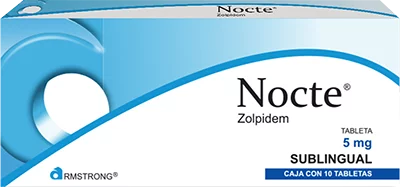
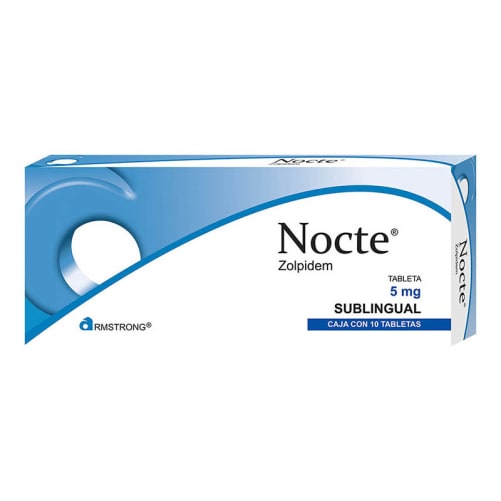
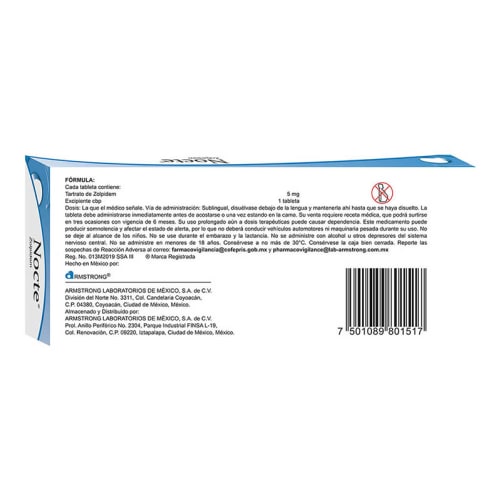
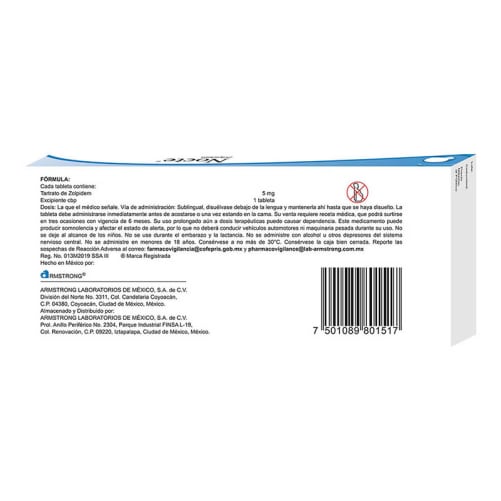
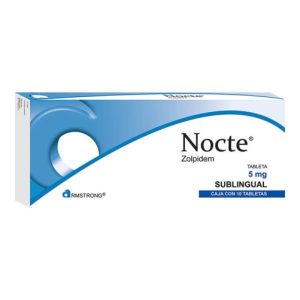

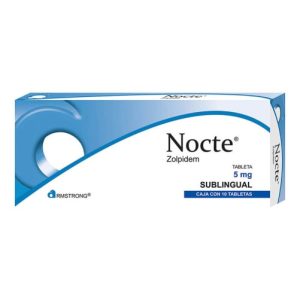
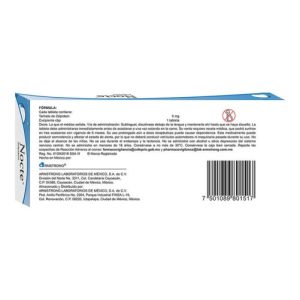
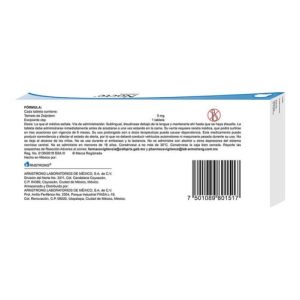
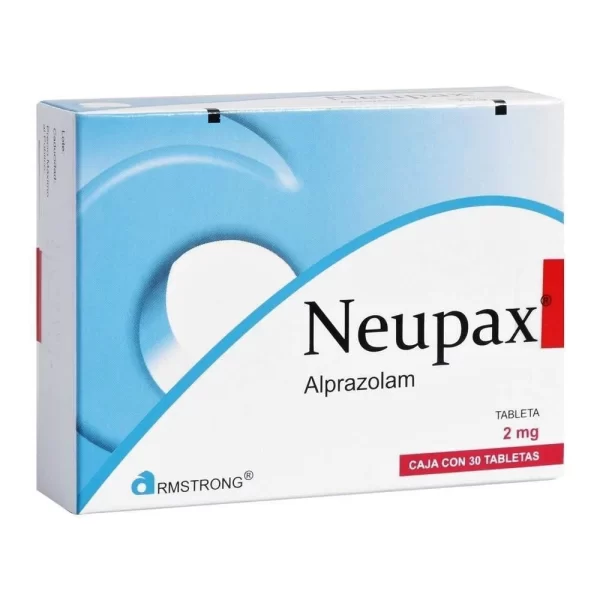
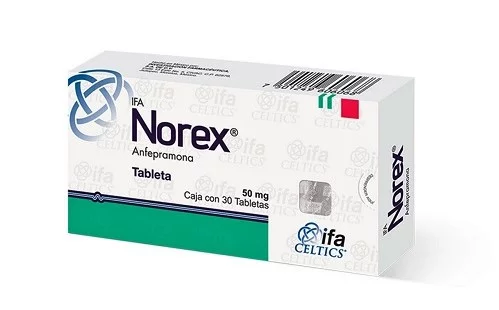
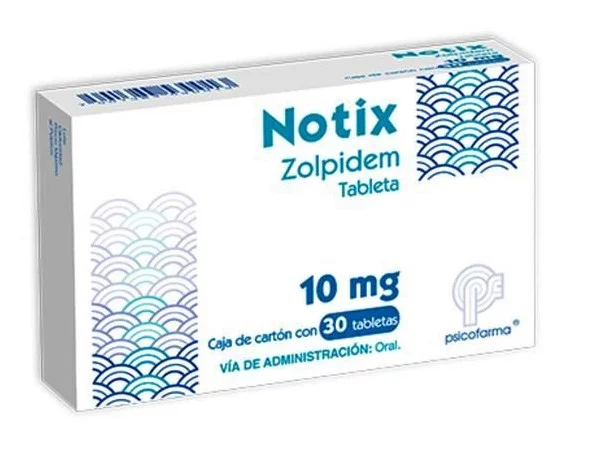
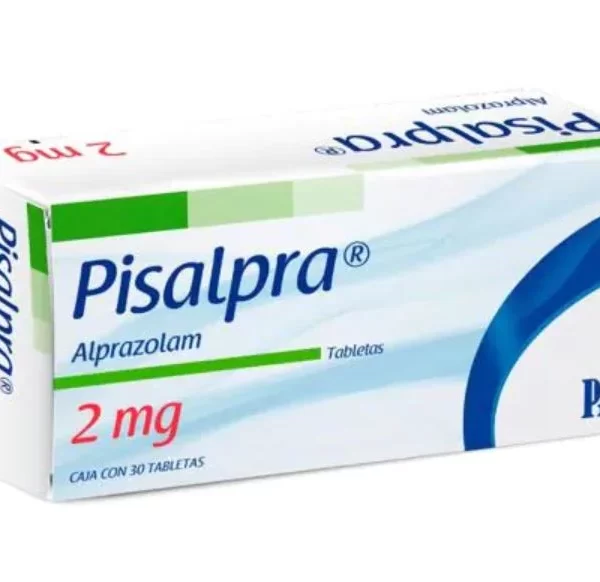
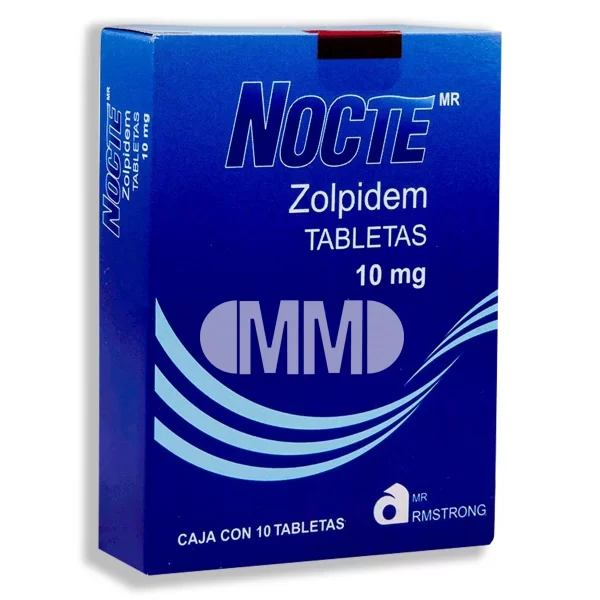
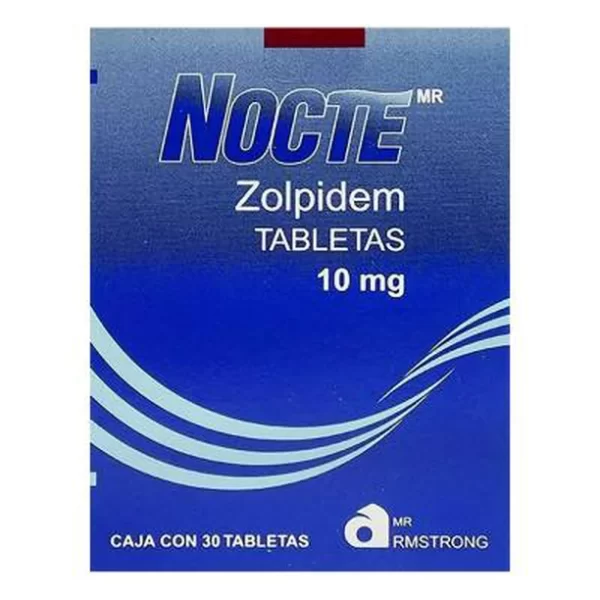
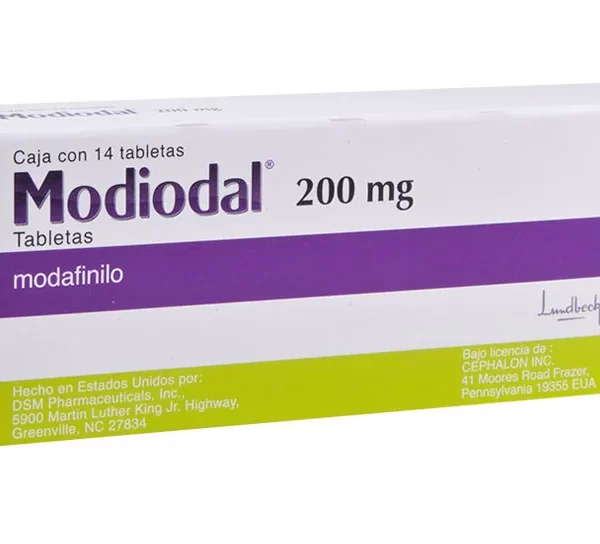
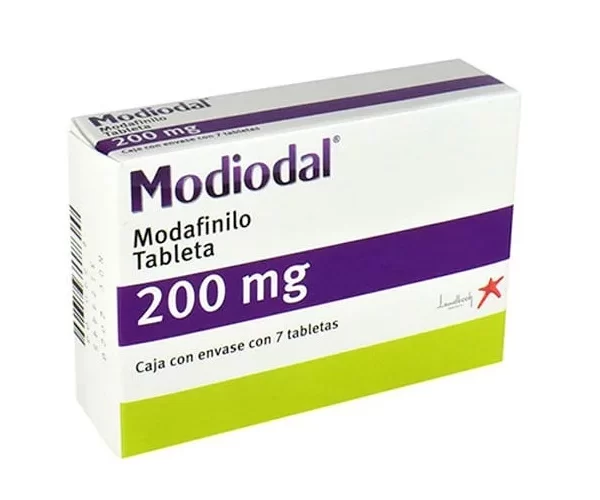
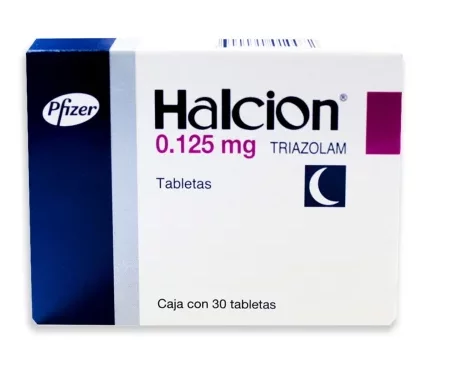
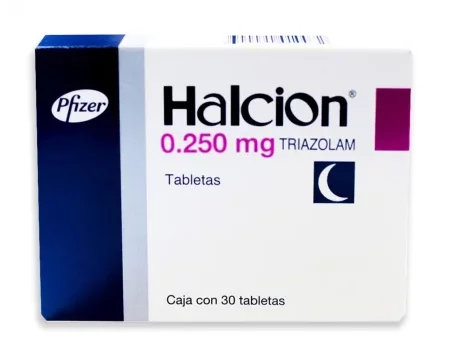
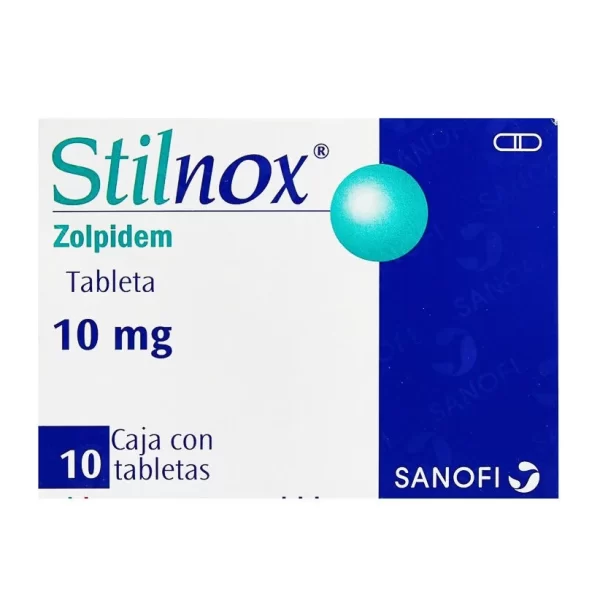
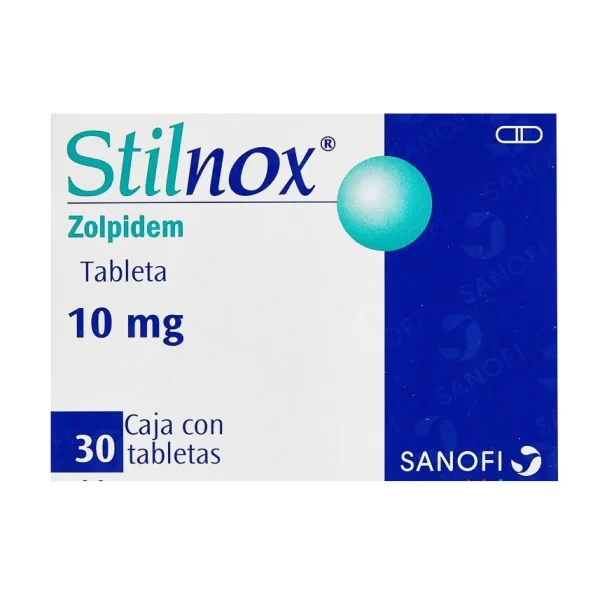
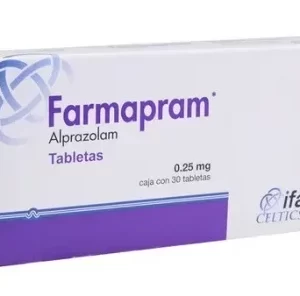
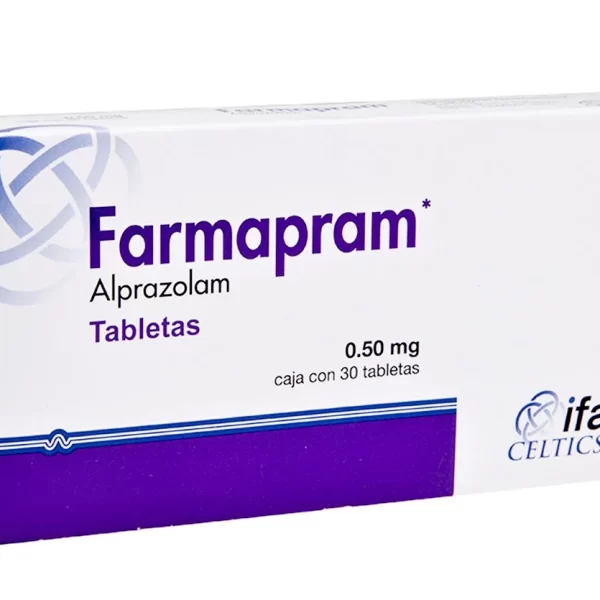
Reviews
There are no reviews yet.